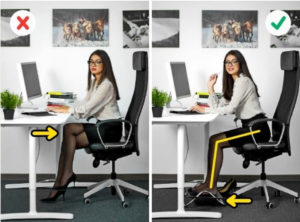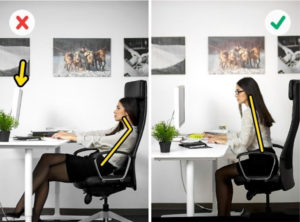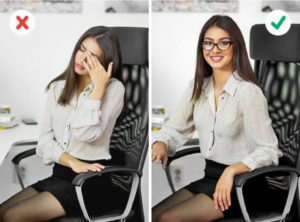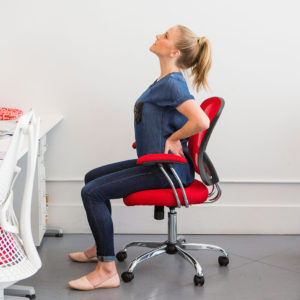You work in an office and have to sit in front of a computer for many hours, but you don’t know the proper and healthy way to sit. Join abninnovation.com to read this article and learn about the correct laptop sitting posture for your health!
The negative effects of sitting with bad posture.
The habit of sitting with bad posture for a long time can lead to health problems. Many scientific studies have shown that people who sit in front of a computer screen for too long can experience vision loss, headaches, and even joint damage such as back pain, shoulder pain, numbness, loss of sensation, loss of appetite, leading to skipping meals.
Furthermore, when you sit on an unsuitable chair (too high or too low), dangling or slouching your legs on the chair can lead to muscle aches and tension on the lower back causing pain, fatigue, and disc and spinal damage, as well as accelerating aging.

Correct sitting posture when working with a computer
Back posture: You should adjust the depth of the chair to fit your hip length. If you sit on a chair with a deep seat, use a back pillow behind you so that your back does not slide down, causing muscle tension and back pain.
Back posture:
Arm posture: The correct arm posture is to fold your arms at a 90-degree angle when typing on a computer, absolutely not to use only your fingers to press the keyboard but to use your entire hand to hold and move the mouse.
The correct arm posture helps you avoid shoulder pain, fatigue, numbness, and tingling in your hands every morning, and also helps you prevent joint inflammation.

Arm posture:
Leg posture: You should adjust the chair to ensure that the head of the chair and the edge of the chair are not at right angles to each other. Absolutely do not cross your legs or wear high heels when sitting for a long time because it can make your legs tired and lead to unwanted damage to your ankle joints.
The best sitting posture is to slightly tilt downward at an angle greater than 90 degrees, and you can also use a footrest when sitting to make you feel most comfortable and keep your muscles healthy, avoiding joint and muscle aches!

Leg posture:
Neck posture: When sitting in front of a computer screen for a long time, you should do light neck exercises such as shaking, bending, and stretching your neck to prevent stiffness and fatigue.

Neck posture:
When sitting in front of a computer screen for long periods of time, remember to perform gentle neck exercises such as shaking, bending, and tilting to prevent stiffness and avoid neck fatigue.

Eye movement:
When you stare at the computer screen for too long, your eyes may become dry, blurry, and even lead to headaches and dizziness. To alleviate this condition, you need to adjust your eye movements accordingly:
How to position the computer screen: You need to place the computer screen at eye level, about 50 cm away from your eyes.
Adjust the screen brightness: Depending on your working position, you can adjust the brightness/darkness of the screen to suit you, as well as adjust the font size so that your eyes are most comfortable.
Do eye exercises: Every 30 minutes you look at the screen, take at least 20 seconds to stand up, walk around, or blink your eyes to give your eyes a break.
Look at green spaces: When you stare at the computer for too long and your eyes get tired, stand up and find a space with trees and green colors, then look at them. Your eyes will feel better.

Some effective movement exercises
During computer use, please practice some physical exercises to help keep your body active and healthy.
Neck fatigue exercise:
Every 2 hours of continuous work, take a few minutes to perform some basic movements such as tilting your head forward and backward, then turning from left to right, repeating this process about 5-10 times to help relax your neck and prevent stiffness and fatigue, good for your bones and joints.
Exercise to prevent shoulder and neck fatigue Most office workers often have to sit hunched over their keyboards all day long, forgetting to relax their bodies, leading to shoulder and neck fatigue. Therefore, you need to perform relaxation exercises for your shoulders and arms, which can help eliminate excess fat in your stomach and reduce the risk of shoulder and neck pain.
First, sit up straight and use both hands to support your hips. Then take a deep breath, pull your stomach in, stretch your shoulders forward for a few seconds, then exhale slowly, pull your shoulders close to your backrest, and push your chest forward. This exercise can help you avoid shoulder and neck fatigue when sitting for too long in front of a computer screen.

Back fatigue prevention exercise
Please sit up straight, place both hands on your thighs, look straight ahead, relax your neck, then hold your hands and hips like this and tilt your body to the left. If you feel your spine is tense, it means you have done it correctly. Repeat this movement 20 times and switch to the right side to perform the same. This exercise not only helps prevent back fatigue but also keeps your spine and neck healthy.

Exercise for the wrists:
First, sit up straight on a chair and place both feet flat on the floor. Then, use your left hand to press the right hand upwards, keeping the arm tight for about 10 seconds and repeat this exercise 5-10 times whenever you have free time. Do the same with the other side. This exercise not only helps relieve fatigue in the arm and shoulder muscles, but also improves blood circulation, keeping your wrists functioning well.

Exercise for the pelvis bone
Pain in the pelvic bone area can cause you to face painful cramps in the lower back, making you uncomfortable. Therefore, keep your back straight, place both hands on your knees, lean slightly to the left and hold this position for a few seconds until you feel like you are sitting on half of your pelvis, which means you have done it correctly. Then repeat this position with the other side. This exercise not only helps to move the pelvic bone smoothly and eliminate excess fat but also helps you to limit joint pain in the lower back.


